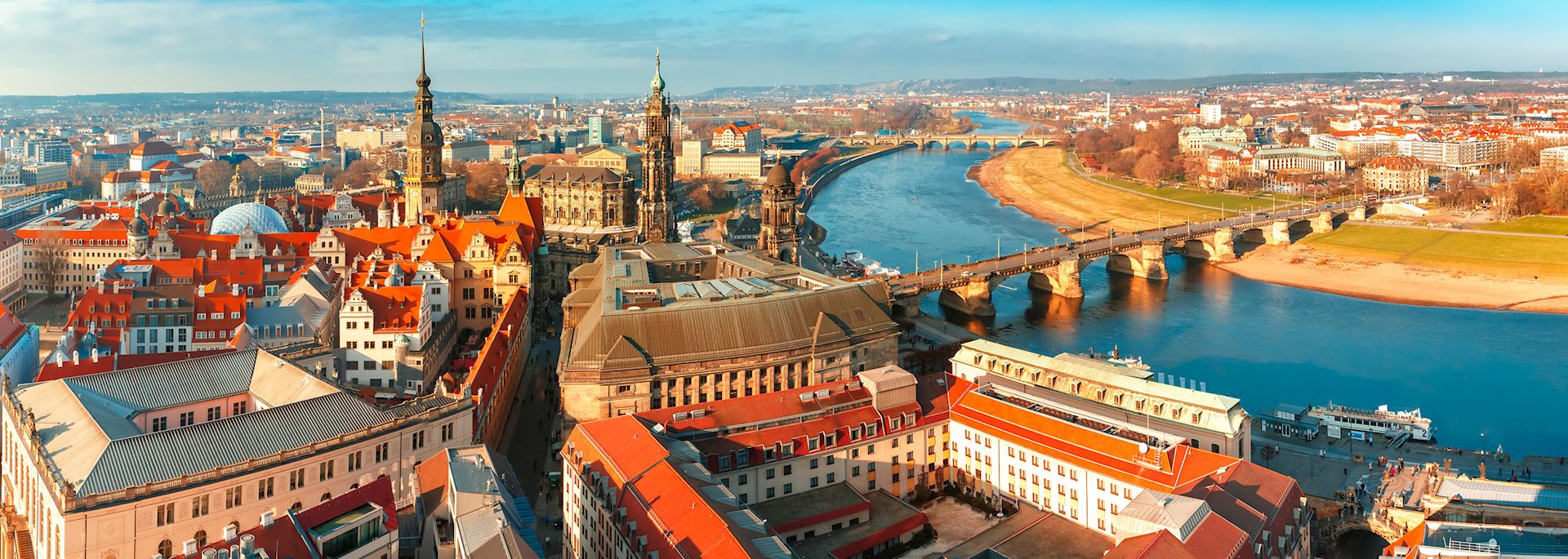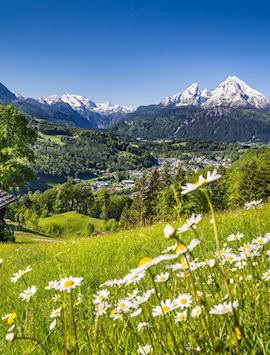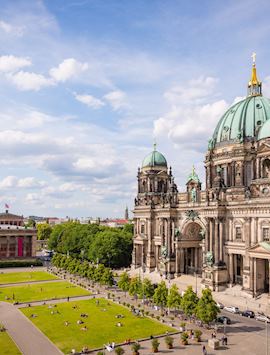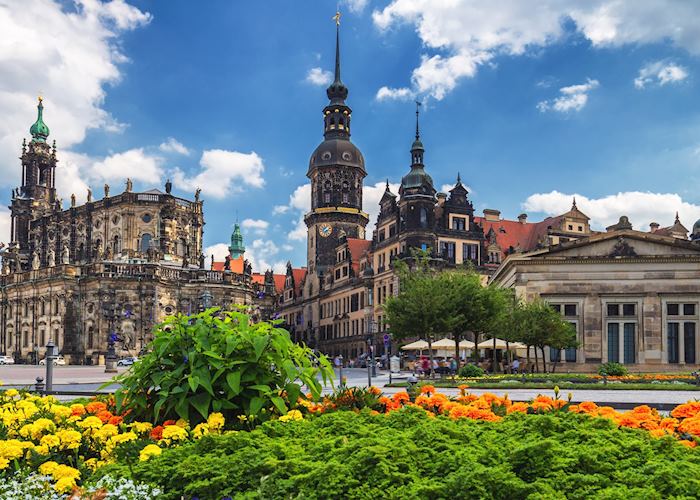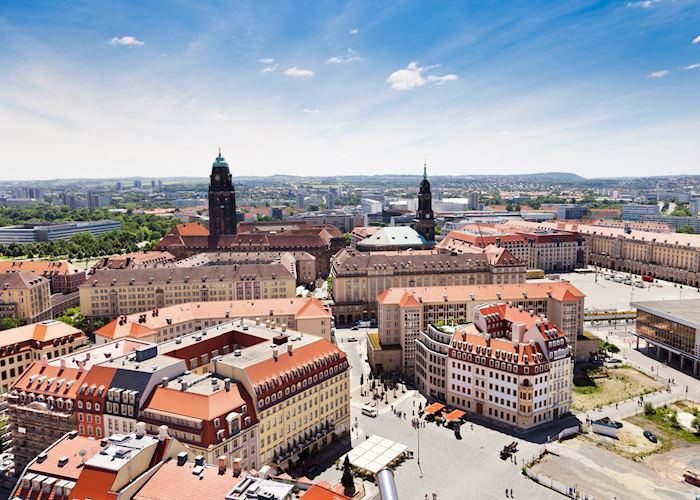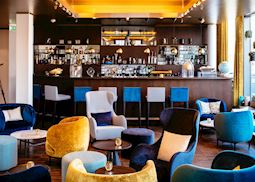Jump to:
A symbolic domed church, a riverfront promenade and a world-renowned opera house, all in Dresden, Germany.
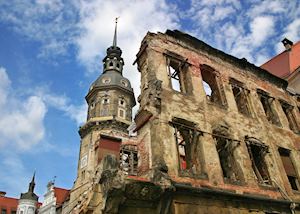 With the spires and domes of its stately buildings along the Elbe River, Dresden has long been a cultural, educational and political hub in Germany and Europe. Though often referred to as a Baroque city, Dresden’s architecture spans everything from Renaissance and Historicism to modernism and postmodernism.
With the spires and domes of its stately buildings along the Elbe River, Dresden has long been a cultural, educational and political hub in Germany and Europe. Though often referred to as a Baroque city, Dresden’s architecture spans everything from Renaissance and Historicism to modernism and postmodernism.
As the capital city of the German state of Saxon, Dresden teems with culture by way of art and music. The Saxon State Opera is one of the best-known in Europe and draws many visitors to the city, hoping to catch the latest show. The city is also home to a handful of art museums, including the Albertinum Museum, which exhibits paintings and sculptures from Romanticism to the present.
Located in the eastern central part of Germany, near the Czech and Polish borders, Dresden is about a 2.5-hour drive from Berlin and a 2.5-hour train ride from Prague.
Things to see and do in Dresden
Frauenkirche
Perhaps no building in Dresden’s skyline provides as distinctive a silhouette as Frauenkirche, or the Church of Our Lady. In many ways, the church’s history mirrors the city’s. It began as a much more humble building in the 11th century, when it was built as a Romanesque church outside the old city walls. Eventually, the walls came down, and so did the church, which was rebuilt to be bigger and grander. A Baroque church went up in its place, featuring a soaring dome that contended with Michelangelo’s at St Peter’s Basilica.
In 1945, the dome fell and the church collapsed after two days and nights of bombings by Allied forces in World War II. The building sat in blackened rubble for 45 years during communist rule, before being resurrected in 1992. Completed in 2004, the church was rebuilt using the original architect’s plans and as many 18th-century techniques as possible. You can visit the Frauenkirche on our two-hour walking tour of Dresden.
Neumarkt
A large, cobbled square anchored by a towering statue of Martin Luther, Neumarkt has long been a central and culturally significant area in Dresden’s old town. The square, which is encompassed by the Frauenkirche and gabled pastel buildings, provides a place for strolling, shopping and dining.
Like much of Dresden, the square was mostly destroyed in the World War II bombings in 1945, but rebuilt after the war in a Socialist Realist style during Soviet occupation. Following German reunification in 1990, the square was again restored, this time to its pre-war look.
Albertinum
Dresden’s modern art museum, the Albertinum is a sandstone Renaissance revival building in the historic central district. The museum is directly across from a park that overlooks the Elbe River, making it a nice place to sit and enjoy the weather on a nice day. As a modern art museum, the Albertinum is home to the New Masters Gallery and Sculpture Collection of the Dresden State Collections.
The exhibits feature both paintings and sculptures from Romanticism to the present, covering a span of about 200 years. We can arrange for you to take a walking tour of the city that includes the Albertinum.
Brühl’s Terrace
If you stroll along Brühl’s Terrace, you’ll see the Elbe River on your left side and Dresden’s stately buildings on your right. Nicknamed the Balcony of Europe, Brühl’s Terrace stretches high above the Elbe and is a popular place for locals and visitors alike to walk or enjoy a cup of coffee.
The terrace was destroyed by the 1945 bombings, but has been restored and is once again one of the city’s biggest landmarks. Its central location near Frauenkirche, Dresden Castle and Theatre Square makes it easy to get to, and a nice place for an afternoon stroll between tours.
Dresden Castle
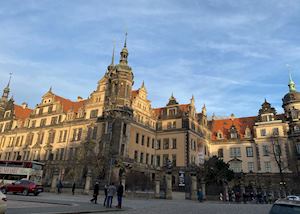 One of the oldest buildings in the city, Dresden Castle spent more than 400 years as the residence of electors and kings of Saxony and Poland. It’s well-known for its mix of architecture, ranging from Baroque to neo-Renaissance.
One of the oldest buildings in the city, Dresden Castle spent more than 400 years as the residence of electors and kings of Saxony and Poland. It’s well-known for its mix of architecture, ranging from Baroque to neo-Renaissance.
It's now a museum complex and houses the Dresden State Art Collections. It holds a variety of exhibits and rooms, including the Green Vault, which contains the largest collection of treasures in Europe. The literal crown jewel is the Dresden Green, a massive green diamond from India.
The building was heavily damaged during the World War II bombings, but all the valuable art inside was spared as it had been moved to a safe location. It has since been restored to its former glory.
Meissen Porcelain
Known for the signature soft cornflower blue used as an underglaze, Meissen Porcelain has been produced about 25 km (15 miles) from Dresden since the early 1700s. Because of this proximity, it’s often referred to as Dresden porcelain, and was the first European hard-paste porcelain. The Blue Onion tableware pattern is likely the most identifiable, and its high quality and artistic value make it desirable to collectors and connoisseurs.
You can see the Dresden Porcelain Collection at Zwinger Palace, which is home to about 20,000 porcelain pieces, including Saxon/Meissen porcelain and a collection of traditional Chinese and Japanese porcelain.
Semperoper
One of Dresden’s biggest draws is its opera house, which has been open since the 1800s and has a long history of premieres, including operas by Richard Wagner and Richard Strauss. The building acts as the opera house for the Saxon State Opera, the concert hall for the Saxon State Orchestra and the home to the Semperoper Ballet. The grand, neo-Renaissance building is located in Theatre Square in central Dresden, on the bank of the Elbe River.
The original building on the site burned down, and was rebuilt and reopened in 1878. That building was then destroyed in the 1945 air raids, but reopened 40 years later in 1985. Its reopening featured Carl Maria von Weber's Der Freischütz, the last opera performed before the building was destroyed. We can arrange for you to see the Semperoper as part of a walking tour of Dresden.
Best time to visit Dresden
Dresden experiences distinct seasons, with a hot summer and cold and snowy winter. The peak season is May through October, when the temperatures are warmest and visitors on summer school breaks flock to the city. Though chilly, December also sees an influx of visitors due to the sparkling Christmas markets.
who's been there
-
617-223-4521617-223-4364
- Make an inquiry
Suggested itineraries featuring Dresden
Our itineraries will give you suggestions for what is possible when you travel in Dresden, and they showcase routes we know work particularly well. Treat them as inspiration, because your trip will be created uniquely by one of our specialists.
Places near Dresden
- Berlin 102 miles away
- Nuremberg 163 miles away
- Bavaria 185 miles away
- Rothenburg 196 miles away
- Munich 226 miles away
- Frankfurt 229 miles away
- Hamburg 241 miles away
- Heidelberg 251 miles away
- The Rhine Valley 270 miles away
- Oberwesel 270 miles away
- Neuschwanstein 276 miles away
- Cologne 291 miles away
- Baden-Baden 295 miles away
Photos of Dresden
Accommodation choices for Dresden
We've selected a range of accommodation options for when you visit Dresden. Our choices usually come recommended for their character, facilities and service or location. Our specialists always aim to suggest properties that match your preferences.
-
![Townhouse, Dachbar]()
Townhouse
Dresden
